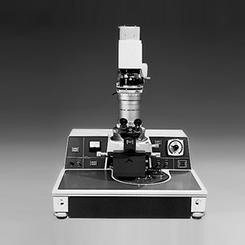History
Landmark moments in intellectual property history
Canon's IP activity started with a trademark registration for "Canon" in 1935.
Since then, we have seen number of evolutions including overseas patent acquisition, winning invention awards, establishing the patent department, and numerous battles with competitors.
We here pick up notable topics from this 85 year-long history of IP activities.
-
1935First trademark registration
The company's first camera prototype was born in 1934, and was named "Kwanon." This name reflected the wish to create the world's best camera in honor of Kannon, the Buddhist goddess of mercy. Soon, a brand name that would have worldwide appeal became needed in order to launch the camera in earnest. "Canon" was then registered as a trademark in the following year. The origin of the design of the current Canon logo is the lettering written in the trademark registration at that time. The tip of the letter "C" is folded inward and sharply pointed, which is a unique design from that time.
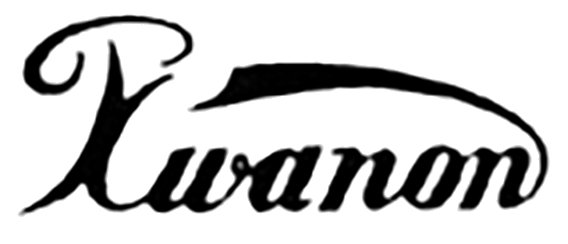
1934- 
1935- 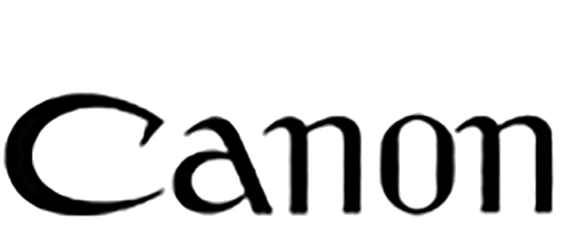
1953- 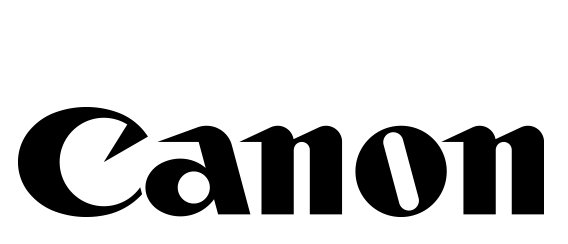
1956-

Kwanon (prototype) -
1943First patent registration
Canon's intellectual property activities began with the acquisition of a utility model for a Canon camera that did not infringe a patent held by Leica (Germany). In 1943, Canon registered its first camera-related patent for "a device that prevents the release of a light-shielding curtain if it is not fully rolled up." Subsequently, recognizing the value of obtaining patents in foreign countries where it did business, Canon registered a U.S. patent related to a camera holder in 1952, which was the company's first in the United States.

Patent No. 156571 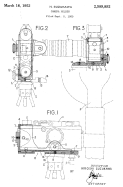
U.S. Patent
No. 2,589,892 -
1958Canon wins the Invention Prize at the National Commendation for Invention (Japan Institute of Invention and Innovation)
From early on, the head of Canon's technology division stressed the need to focus on patents and designs to promote the creation of the world's best products, and Canon made an effort to develop original technologies and obtain patent rights for them. The first time Canon won an award was in 1958, when the company was awarded the Invention Prize at the National Commendation for Invention sponsored by the Japan Institute of Invention and Innovation for inventions of outstanding achievement. Canon has received many awards since then, including the Imperial Invention Prize, the Science and Technology Agency Director-General's Award, the Japan Patent Office Director-General's Award, the Japan Chamber of Commerce and Industry President's Invention Award, and the Asahi Shimbun Invention Award. Canon has also continued to receive numerous awards since the dawn of the 21st century, including the Prime Minister's Award.
-
1958Patent Section established
As Canon's R&Ds began to expand into fields other than cameras and optical equipment, the Patent Section was established in the Engineering Department in concert with the consolidation of the R&D Division's structure. At that time, the Patent Section consisted of only four people, and its main job was to act as an intermediary between in-house inventors and outside patent attorneys. Subsequently, it was expanded with the goal of ensuring that the outcomes of R&D resulted in patents, and a system was created to promote intellectual property activities in line with the development of businesses.
-
1960Regulations established for handling of intellectual property rights
In 1960, as a measure to encourage inventions/creation, Canon established "Rules for Handling Patent Rights, Utility Model Rights, and Design Rights Related to Inventions and Devices," "Guidelines for the Handling of Affairs" and "Rules of the Patent Examination Committee." The company made it clear that it would pay a compensation to employees who actively engaged in R&D and turned the results into intellectual property rights, which stimulated development activities. Canon's basic system for efforts related to employee inventions took shape at this time.
-
1960sThe start of patent battles
Canon began to develop copying machines in the 1960s. At the time, it was thought to be impossible to develop a copying machine that did not infringe the patent portfolio of Xerox Corporation, which had a monopoly in the market for plain-paper copy machines, but in 1965 Canon succeeded in developing a unique system called "NP system" that dodged Xerox Corporation's rights. In advance of the copying machine business, Canon formed a strong patent portfolio related to the NP system, and started the copying machine business in 1967. After various battles, however, Canon signed a cross-licensing agreement with Xerox Corporation in 1978. From this challenge, the importance of patent strategy in business spread throughout the company, and Canon's stance of focusing on intellectual property activities has been passed down to the present day.

Canon's first copying machine: NP-1100 -
1987Establishment of the Trade Name and Trademark Council
The Trade Name and Trademark Council, established in 1987, stipulated measures such as rules for the use of "Canon" in trade names, trademarks and the use of the Canon logo to maintain and enhance the Canon brand. Since then, while the committee has experienced name changes to the Mark Management Committee (2003) and the Brand Management Committee (2011), the head of the intellectual property division has served as the chairperson of the committee, which works in cooperation with related divisions to maintain and enhance the Canon brand while placing the utmost importance on the standpoint of total optimization of the Canon Group.
-
1987Canon ranked No.1 for the first time for the number of U.S. patent registrations in a single year
Having become a company with a high level of awareness of patents, Canon has been proactive in obtaining patents in the United States, which is the world's largest market. In 1987, Canon attained the No.1 rank in the number of U.S. patent registrations for the first time. In that year, three of the top five companies were Japanese companies. Canon's stance of focusing on U.S. patents has been continued to this day, and Canon has been placed in the top five in the U.S. patent registration number rankings for 35 consecutive years since 1986.
Rank Company name Cases 1 Canon 846 2 Hitachi 845 3 Toshiba 824 4 General Electric Company 779 5 U.S. Philips Corporation 687 -
1989Name changed to Corporate Intellectual Property and Legal Headquarters
The intellectual property division has been strengthened over the years, with the number of personnel increasing in line with growth in the number of patent applications and license negotiations. The name of the division also expanded, becoming the "Patent Department" in 1972, the "Patent Legal Center" in 1983, and the "Patent Legal Headquarters" in 1987. In 1989, because the division handles not only patents, but also various other kinds of intellectual property such as designs, trademarks, and trade secrets, the name was changed to "Corporate Intellectual Property and Legal Headquarters." Today, it is an organization staffed by several hundred people.
-
1990Single-year licensing income exceeds 10 billion yen
The main purpose of Canon's intellectual property activities is not to obtain licensing income, but to support the development of businesses. By holding a large number of strong patents, however, we have been able to file infringement suits against third parties who infringe our patents, and contributed to the development of businesses by making cross-licensing agreements with competitors securing freedom to operate for our businesses. In a cross-licensing arrangement, the stronger patent holder can obtain licensing income and Canon's single-year licensing income surpassed 10 billion yen in 1990, and has remained high ever since.
-
2000sStart of battles with PAEs in the U.S.
The start of the 2000s saw the emergence of patent assertion entities (PAEs) in the U.S. PAEs purchase patents but do not make products with them and earn income primarily through patent litigation against operating companies. Since then, PAEs have filed a number of lawsuits against Canon as well, but we have resolutely stood up against baseless and frivolous lawsuits and have scored total victories in several cases.
-
2001Launch of Invention harvesting meeting
At Canon, ideas that lead to patents are called (patent) proposals. These ideas are documented by the inventor in the form of a proposal. The job of IP departments is to capture the essence of the invention— i.e., to capture a technical concept from the proposal. Once the technical concept is captured, IP staff members or patent attorneys draft the patent description and file the patent application. In the 1990s and early 2000s, Canon filed around 10,000 patent applications a year. But with the demand for shorter development periods, it has become found that there exist some proposals that were not drafted based on sufficient consideration. Another issue was the increase in cases where the process of converting ideas into technical concepts significantly altered the details of patent descriptions from the original proposal. Dealing with these cases was taking up a large amount of resources. As a result, in 2001, Canon started examining proposals at the ideation stage to ascertain the essence of the inventions, including their patentability potential. The results are assessed and decisions are made on how far to refine the details of each proposal in drafting a patent description. This system of appraising and enhancing ideas took root and is still in place today.
-
2003Establishment of Canon Technical Information Services Inc.
Part of the Corporate Intellectual Property and Legal Headquarters was spun off in 2003 to form Canon Technical Information Services. With the dramatic increase in the number of patent applications and the growing importance of patent search services, Canon Technical Information Services began providing patent search services to Canon Group companies worldwide with the aim of strengthening and streamlining patent search operations.
-
2010sStart of active enforcement against compatible consumables that infringe Canon patents
We have strengthened our patent enforcement activities against compatible consumables that infringe Canon patents and actively filed litigation in many countries around the world.
-
2010s and onwardAccelerating cross-license arrangements with overseas IT companies
In an era where everything can be connected and the number of functions implemented in a single product has expanded dramatically, it becomes essential for a company to collaborate with other companies in different industries. In anticipation of such trends, Canon proactively started a series of license negotiations with companies in different industries, particularly overseas IT companies, in the 2010s. By entering into cross-license agreements early on with not only business competitors but also non-competitors possessing necessary technologies, Canon has been able to secure freedom for its future business endeavors and reduce litigation risks.
-
2014Establishment of the LOT Network
From around 2009 to 2013 the number of patent lawsuits in the U.S. skyrocketed, reaching a record high in 2013 with more than 6,000 cases. The main driver of this dramatic increase was the surge in litigation by PAEs, which victimized many companies operating legitimate businesses. To counter the threats posed by PAE lawsuits, Canon established the License on Transfer Network (LOT Network) in 2014, in partnership with five companies including Google. Read more
Intellectual property history by business field
Canon's IP activity has moved forward and evolved with business activities.
The mindset of putting value on IP has deeply rooted within the company through various challenges, which boosts the IP activities based on close communication between business units and the IP section.
Here we introduce our efforts and achievements in 4 (four) businesses: printing, medical, imaging and industrial.
-
Printing
The history of Canon's intellectual properties in the printing field
Read more
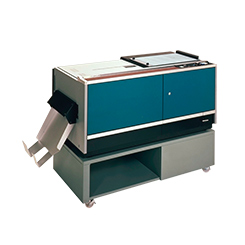
-
Medical
The history of Canon's intellectual properties in the medical field
Read more
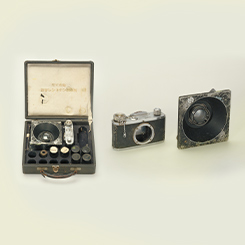
-
Imaging
The history of Canon's intellectual properties in the imaging field
Read more
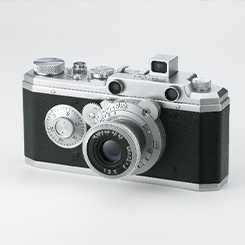
-
Industrial
The history of Canon's intellectual properties in the industrial field
Read more
